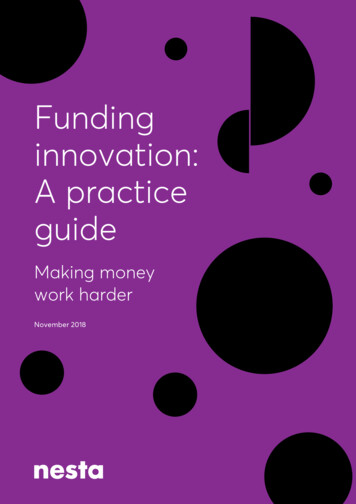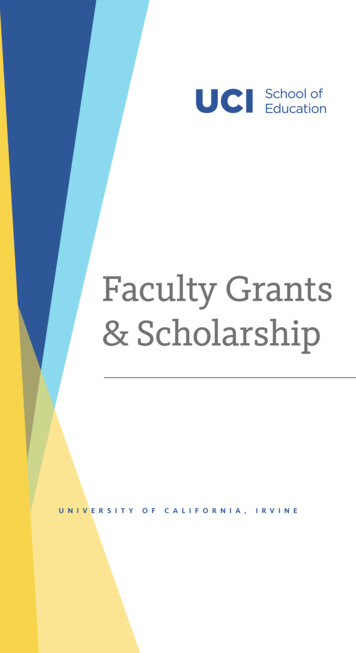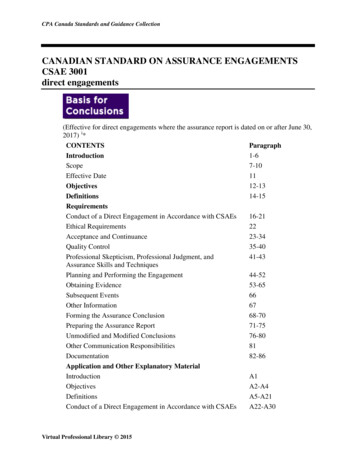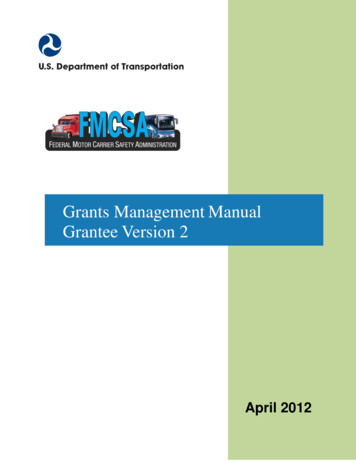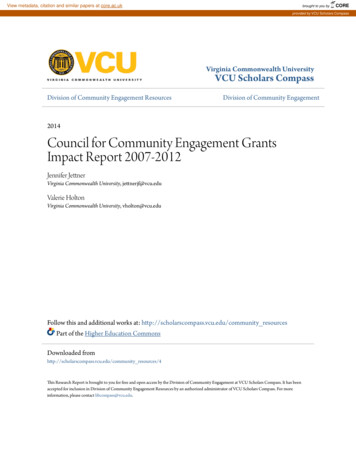
Transcription
View metadata, citation and similar papers at core.ac.ukbrought to you byCOREprovided by VCU Scholars CompassVirginia Commonwealth UniversityVCU Scholars CompassDivision of Community Engagement ResourcesDivision of Community Engagement2014Council for Community Engagement GrantsImpact Report 2007-2012Jennifer JettnerVirginia Commonwealth University, jettnerjf@vcu.eduValerie HoltonVirginia Commonwealth University, vholton@vcu.eduFollow this and additional works at: http://scholarscompass.vcu.edu/community resourcesPart of the Higher Education CommonsDownloaded fromhttp://scholarscompass.vcu.edu/community resources/4This Research Report is brought to you for free and open access by the Division of Community Engagement at VCU Scholars Compass. It has beenaccepted for inclusion in Division of Community Engagement Resources by an authorized administrator of VCU Scholars Compass. For moreinformation, please contact libcompass@vcu.edu.
Council for Community Engagement Grants Impact Report 2007-2012AbstractAs Virginia Commonwealth University (VCU) takes its place among the nation‟s top 50 public researchuniversities, our guiding principles have been an abiding focus on student success at all levels, unparalleledinnovation through research, and a university-wide commitment to human health, and engagement andempowerment in our communities. To that end, VCU has named community engagement as a key focus areain its strategic plan with the aim of developing collaborative university-community partnerships that yieldcreative and relevant solutions for community-identified needs. These mutually-beneficial partnerships notonly support the public good, but they also support our mission to advance knowledge and student successthrough teaching and learning, scholarship, and outreach efforts.The Council for Community Engagement (CCE) Grants is one way that VCU supports the development ofsustainable, mutually-beneficial partnerships. Under the direction of the vice provost for communityengagement and the vice president for health policy and community relations of the VCU Health System, theCouncil provides oversight for the CCE Grants. The CCE projects are designed to enhance and increaseuniversity engagement with the community and contribute to community-engaged scholarship. One-yearseed grants of up to 20,000 are awarded to proposals that demonstrate the involvement of faculty andstudents, address community-identified needs, and demonstrate substantive collaboration with at least onecommunity partner.Over the past 7 years (2007-2014 grant years), 581,871 has been awarded to fund 51 community-basedscholarship projects, which have involved 107 faculty from 19 academic and academic support units,representing 68 different departments and over 76 community partners (Appendix A). These projects havelargely focused on improving health & wellness (34%), education (26%), environmental sustainability (14%),positive youth development (14%) and other (12%).This evaluation examined the impact of the seed grant program from 2007-2012 grant years (2007 – 2011calendar years) from the perspectives of the community partners, PIs and students. Two overarchingquestions guided this evaluation: 1) do the grants facilitate successful community-university partnerships, and2) can seed grant money be a catalyst for long-term partnerships. Although not included in the currentevaluation, it is worth noting that two recently funded (2012-13) CCE grantees have already demonstratedsuccessful impact. VCU‟s School of Nursing recently received a 1.5 million grant from the US Departmentof Health and Human Services to expand the CCE grant, “Community Health and Wellness Program forOlder Adults”. In addition, the “CMoR Learning: Developing Interdisciplinary Partnerships for an InclusiveLearning Community” CCE grantee has been ranked in the nation‟s top 10 as a model for children‟s learningmuseums.KeywordsCouncil for Community Engagement, seed grant, community engagement, grant, impactDisciplinesHigher EducationThis research report is available at VCU Scholars Compass: http://scholarscompass.vcu.edu/community resources/4
Virginia Commonwealth UniversityCouncil for Community Engagement GrantsImpact Report 2007 - 2012April 3, 2014Prepared by:Jennifer Jettner, PhD Candidate, MSWGraduate AssistantDivision of Community EngagementValerie L. Holton, PhD, LCSWDirector, Community-Engaged ResearchDivision of Community Engagement
Council for Community Engagement Grants2Table of ContentsRecommended Citation: . 3Executive Summary. 4Introduction . 4Key Findings . 5Recommendations . 5Background . 6VCU‟s Commitment to Community Engagement . 6Council for Community Engagement . 7CCE Grants . 7The Current Evaluation . 8Methodology . 10Data Sources . 10Response Rates . 10Goals & Objectives . 12Goals & Objectives Met . 12Factors that led to Success . 13Challenges . 13Unexpected Outcomes . 14Project Status. 15Reasons the project ended . 16How the project changed over time. 16Community-University Partnerships . 17Maintaining Partnerships . 17Prior Relationship . 18Role of PI and Desired Role . 18Exchange of Resources . 19Financial Sustainability . 21Seeking or Receiving Additional Funds . 21Source of Additional Funds Sought or Received . 22
Council for Community Engagement Grants3Funding Received . 23External versus Internal Sources of Funding Received. 24Faculty Scholarship . 25Status of Scholarship Development. 25Types of Scholarship Developed . 25Number of Scholarly Products. 27Student Involvement & Scholarship . 28Student Involvement . 28Student Scholarship . 30Ongoing Impact . 31Ongoing Impact . 31Remaining Challenges . 32Summary & Implications . 33Summary . 33Key Findings . 33Recommendations . 34References . 35Appendix A: List of CCE Grants (2007-2014) . 38Appendix B: Faculty (PI) Follow-up Survey . 41Appendix C: Community Partner Follow-up Survey . 46Appendix D: List of CCE Grants Represented in Impact Report . 51Appendix E: Additional Funding Sources . 53Appendix F: Faculty Scholarship. 54Appendix G: Student Scholarship . 57Recommended Citation:Jettner, J., & Holton, V. (2014). Council for Community Engagement Grants: Impact report 2007-2012. VirginiaCommonwealth University. Richmond, VA. Retrieved from Virginia Commonwealth University, Division ofCommunity Engagement website: www.community.vcu.edu
Council for Community Engagement Grants4Executive SummaryIntroductionAs Virginia Commonwealth University (VCU) takes its place among the nation‟s top 50 public researchuniversities, our guiding principles have been an abiding focus on student success at all levels, unparalleledinnovation through research, and a university-wide commitment to human health, and engagement andempowerment in our communities. To that end, VCU has named community engagement as a key focus area inits strategic plan with the aim of developing collaborative university-community partnerships that yield creativeand relevant solutions for community-identified needs. These mutually-beneficial partnerships not only supportthe public good, but they also support our mission to advance knowledge and student success through teachingand learning, scholarship, and outreach efforts.The Council for Community Engagement (CCE) Grants is one way that VCU supports the development ofsustainable, mutually-beneficial partnerships. Under the direction of the vice provost for community engagementand the vice president for health policy and community relations of the VCU Health System, the Councilprovides oversight for the CCE Grants. The CCE projects are designed to enhance and increase universityengagement with the community and contribute to community-engaged scholarship. One-year seed grants of up to 20,000 are awarded to proposals that demonstrate the involvement of faculty and students, address communityidentified needs, and demonstrate substantive collaboration with at least one community partner.Over the past 7 years (2007-2014 grant years), 581,871 has been awarded to fund 51 community-basedscholarship projects, which have involved 107 faculty from 19 academic and academic support units, representing68 different departments and over 76 community partners (Appendix A). These projects have largely focused onimproving health & wellness (34%), education (26%), environmental sustainability (14%), positive youthdevelopment (14%) and other (12%).This evaluation examined the impact of the seed grant program from 2007-2012 grant years (2007 – 2011calendar years) from the perspectives of the community partners, PIs and students. Two overarching questionsguided this evaluation: 1) do the grants facilitate successful community-university partnerships, and 2) can seedgrant money be a catalyst for long-term partnerships. Although not included in the current evaluation, it is worthnoting that two recently funded (2012-13) CCE grantees have already demonstrated successful impact. VCU‟sSchool of Nursing recently received a 1.5 million grant from the US Department of Health and Human Servicesto expand the CCE grant, “Community Health and Wellness Program for Older Adults”. In addition, the“CMoR Learning: Developing Interdisciplinary Partnerships for an Inclusive Learning Community” CCE granteehas been ranked in the nation‟s top 10 as a model for children‟s learning museums.
Council for Community Engagement Grants5Key FindingsThe CCE grants have demonstrated success on the following key impact domains: sustainability, contribution tofaculty and student scholarship and ongoing impact. Overall, 47% (n 16) of the 34 grants have continued past the funding period. Grantees obtained 648,400 in extramural funding; 76% of which were from external VCU sources.Thus, for each dollar invested during 2007-2012 ( 476,407), grantees were able to leverage 1.36 tosustain the projects. Faculty developed approximately 115 scholarly products through the grant funded projects. 792 VCU students have been involved with the CCE projects, of which 53% were undergraduates and47% were graduates. The primary activity of student involvement was through service-learning (63%). Grantees report that the on-going impact of the community-university partnership has had a “multipliereffect” by simultaneously increasing faculty, partner staff and student competencies while engagingadditional VCU and community partners over time.Recommendations Continue to fund the Council’s Community Engagement Grant program – Based on the results of thisimpact study, it is strongly recommended that the grants continue. They have demonstrated their ability toact as a catalyst to meet community identified needs within a collaborative partnership that has enhancedfaculty scholarship (e.g. 115 scholarly products) and have provided a real world context for 792 VCUstudents to apply classroom content in a financially sustainable way. Continue to invest in partnerships – It is recommended that the grant program remain focused onstrengthening sustainable community-university partnerships that address community-identified needs andopportunities that align with VCU‟s mission. Encourage grantees in planning for sustainability – Grantees should be encouraged to more intentionalin planning how they will maintain and further develop the seed projects with external funding and/orobtaining resources through institutionalizing partnerships (i.e., service-learning courses).
Council for Community Engagement Grants6BackgroundVCU‟s Commitment to Community EngagementAs Virginia Commonwealth University takes its place among the nation‟s top 50 public research universities, asdetermined by The Center for Measuring University Performance, our guiding principles have been an abidingfocus on student success at all levels, unparalleled innovation through research, and a university-widecommitment to human health, and engagement and empowerment in our communities. VCU strengthened itsposition as a top-ranked urban, public research university and earned “Research University, Very High ResearchActivity” status, as well as Community Engagement Classification from the Carnegie Foundation, one of only 28national public research universities with academic medical centers that hold both distinctions. In building on itscommitment, the current strategic plan emphasizes community engagement as a focus in itself (one of the fourthemes of the strategic plan states that VCU will, “become a national model for community engagement andregional impact”) and includes community engagement as a means to providing high quality learning experiencesand advancing excellence in research. Partially due to its commitment in community engagement, the university isone of 60 institutions with a NIH-sponsored Clinical and Translational Sciences Award. In order to promoteVCU‟s mission, the Division of Community Engagement, housed in the Office of the Provost, supports andcoordinates community engaged teaching, research, and outreach.VCU‟s commitment to community-university partnerships is significant, but not unique. It is founded on agrowing body of research demonstrating the importance of these relationships for modern universities tomaintain relevance in the 21st century. Community-university partnerships ideally strengthen the capacity of allpartners to address complex social problems. They increase social networks and, in turn, utilize social capital topromote economic and community development. It is through these partnerships that universities become furtherembedded and invested in their communities (Shannon & Wang, 2010), while also serving as a bridge todisseminate solutions that span the local to the global (Strier, 2011).Community-university partnerships can directly support the mission of the university by enhancing research,teaching and service. Collaborative partnerships can merge resources to produce innovative and relevant researchthat addresses community-identified needs (Berg-Weger, Herbers, McGillick, Rodriguez, & Svoboda, 2007;Frazier, Abdul-Adil & Atkins, 2007). Partnerships can also provide opportunities for students to engage in a realworld context for classroom content; thus bridging theory and practice (Buys & Burnstall, 2007; Jarvis-Selinger,Lauscher, Liman, Woollard, & Buote, 2008; Lockwood, Lockwood, Krajewski-Jaime, & Wiencek, 2011; Peterson,2009; Strier, 2011). Finally, community-university partnerships enhance the capacity of faculty and students to bethe citizens of today and tomorrow as they engage in service with their communities (Baldwin, Johnson &Benally, 2009; Mahoney, Levine & Hinga, 2010; Rozas & Negroni, 2008).Increasingly complex financial circumstances complicate efforts to document and intensify mission-focused effortsto strengthen their affiliated communities. Yet, universities are seeking to institutionalize their commitment to
Council for Community Engagement Grants7community-engagement through public missions and strategic plans (Dubb, McKinley, & Howard, 2013; Weerts& Sandmann, 2010) as well as “hard money” targeted to supporting these efforts. Institutional support in theform of “hard money” is critical to successful partnerships and is an indicator of a high level of sustainability forthe institutionalization of support for engagement activities (Chadwick & Pawloski, 2007).While the literature identifies some characteristics of effective strategies to support community-engagement, fewstudies have assessed the impact of seed grant programs in this area. In an evaluation of two seed-grant programs,Leisey, Holton, and Davey (2012) found that the grant-funded projects had positive benefits for faculty, students,and community partners and were associated with enhanced service delivery, high quality learning experiences,and published community-engaged scholarship. Zuiches (2013) found that such grants were effective incentivesfor faculty to partner with community members and that faculty awarded these grants were more successful inobtaining other grants compared to those who were not awarded seed funding. The current study presents aneffort to evaluate the impact of VCU‟s CCE seed grant program over a five year period.Council for Community EngagementThe Council for Community Engagement (CCE) is an assembly of representatives from all academic and majorsupport units who seek to facilitate the initiatives associated with our goal of being a national model forcommunity engagement. Under the direction of the vice provost for community engagement and the vicepresident for health policy and community relations of the VCU Health System, the Council: 1) builds a networkof contacts across VCU units, 2) receives and disseminates information and resources that promotes and supportscommunity engagement, 3) gathers information from the community on critical needs and opportunities, 4)recognizes accomplishments of community-university partnerships, and 5) assists in the coordination of eventsdesigned to engage the VCU community with community partners to address community identified needs.Beginning in 2007, the CCE has provided grants specifically for community engaged projects as one mechanismto meet these objectives.CCE GrantsWith support from the offices of the provost and the vice president for health sciences, the CCE provides oneyear seed grants up to 20,000 to support interdisciplinary projects that will enhance and increase universityengagement with the greater Richmond community and will contribute to the research and teaching of VCUunits.CCE grants aim to advance community-engaged scholarship in any academic or academic support unit, and cansupport a broad array of activities. Therefore, proposals are encouraged from across VCU in partnership with avariety of Richmond-area organizations to creatively address community-identified needs. Funded projects areintended to serve as catalysts for on-going partnerships sustained by external funding that strengthen communityengaged research, teaching and/or service.Proposals require a partnership from:
Council for Community Engagement Grants8 At least two units from VCU or VCU Health System. “Units” include academic and academic supportdepartments. Only VCU/VCUHS full-time faculty and staff are eligible to serve as Principal Investigator(PI). At least one community organization from the Richmond Metropolitan Statistical Area. A “communityorganization” may be a government agency, community or nonprofit organization, school or an affiliate ofa local membership organization.The CCE defines partnerships as “a sustained collaboration between institutions of higher education andcommunities for the mutually beneficial exchange, exploration and application of knowledge, information, andresources.”In addition to the grant requirements, projects must align with one of the focus areas of the VCU‟s Quest forDistinction, result in measurable outcomes (e.g. product development, increased capacity, strengthenedrelationships), and demonstrate the potential to leverage support from extramural funders. Preference is given toproposals that include partnerships that span both campuses (if appropriate) to meet community-identified needs,involve students and contribute to faculty and students‟ research trajectory.The Current EvaluationThe DCE is responsible for leading the evaluation described here. Only CCE grants funded for grant years 20072008 through 2011-2012 (5 years) were included in the study. This evaluation was begun in 2012, therefore,projects funded after 2011 were not included. The evaluation blended existing data sources and newly-collectedinput from community partners to develop a unified assessment of funded project outcomes. In general,evaluating grant-making efforts is difficult, particularly when funds support multiple stakeholders in projects ofvariable duration and design and conducted at different periods in time. Additionally, as grant programs develop,they often shift the focus of funding priorities and data collection efforts in response to changing universitypriorities. This evaluation faced these challenges as well, including the need to aggregate information frommultiple sources obtained under different protocols.Two overarching questions guided this evaluation: 1) do the grants facilitate successful community-universitypartnerships, and 2) can seed grant money be a catalyst for long-term partnerships.Based on the literature and programmatic needs, impact of the CCE grants was evaluated along the followingdomains: The project‟s history such as meeting goals and objectives, The current status of the project, The quality of the community-university partnership, Financial sustainability, Scholarship that had developed,
Council for Community Engagement Grants9 Continued student involvement & scholarship and On-going impact.Information from both principle investigators and community partners were solicited to provide a comprehensive view onthe impact of the CCE grant project as well as multiple perspectives on the quality of the community-university partnership.
Council for Community Engagement Grants10MethodologyData SourcesInformation from principle investigators (PI) and community partners were solicited from the 38 grants awardedduring 2007 – 2011 calendar years (2007-2012 grant years). Three sources of data were used: 1) final grant reportsfrom project PIs, 2) PI surveys, and 3) community partner surveys. Each contained a mixture of fixed- and openended response questions. All addressed the following domains, although the item-wording varied: attainment ofproject goals and objectives, current project status, quality of the community-university partnerships, financialsustainability, scholarship, student involvement, and on-going impact.PIs were required to submit a final report at the end of their project‟s funding period. In order to capture themost current status of these partnerships, we limited our analyses to final reports for projects funded in 20102011 calendar years (2010-2012 grant years). PI data for projects funded in earlier years were captured via a followup survey in 2013 as described below.In 2010, the university changed its approach to monitoring and evaluation for this program. A survey wasdeveloped containing questions similar to those in the final report, but focused on project outcomes beyond thefunding period. The survey included project details, including a list of the project‟s goals and objectives, which thestudy team extracted from the grant application. This survey was administered in an online format to project PIsfunded from calendar years 2007-2009 (n 23). PIs funded in calendar years 2010-2011 (n 12) completed onlythe final report for a total of 35 PIs contacted. All community partners (n 32) involved with projects from 20072011 (calendar years) were invited to complete a parallel online survey in 2013.Response RatesFor surveys, PIs and community part
Virginia Commonwealth University VCU Scholars Compass Division of Community Engagement Resources Division of Community Engagement . Jennifer Jettner, PhD Candidate, MSW Graduate Assistant Division of Community Engagement Valerie L. Holton, PhD, LCSW . This evaluation examined the impact of the seed grant program from 2007-2012 grant years .







